Classical Art (Greek and Roman)
Minoan Period
culture in are delevoped
Geometric period
end of dark ages → patterns/lines/shapes
horror vacui → fear of empty spaces (fulled artworks)
900 → 700 BC
expansion through trade and colonisation
religion established
Archaic Period
700 → 480 BC
Athens began establishing itself
Classical Period
450 → 323 BC
birth of literature, philosphy and creative art
Hellenistic Period
323 → 166 BC
Invasion by persian and spartans
Death of Alexander the great
greek culture incorporated in the Roman culture
Greek Life and Beliefs
excellence is based on laws of nature and reason
humans were the center of the philosphy
Greek gods were anthropomorphic (human like)
Believed gods lived on olympus
humans and gods centered on a relationship of exchange
Apollo
god of light, sun, truth and prohecy
heroic
Dionysus
wine, exctasy and intoxication
opposite of Apollo
Hades
god of the underworld
Amphora → two handles jar with a narrow neck
carries wine and oil
Krater
greek vessel for mixing water with wine (watering it down)
Terracotta
hard red unglazed earth clay
Archaic Period
Kouroi (sculpture of naked male youth) and Kore (statue of woman)
male kouroi figures based on egpytian statues
naturalistic
atheletic body, ideal form for a young greek male at that time
female kore clothed → artists spent time perfecting the folds in the clothing
Archaic smile
was considered realism for the greek public
Kouros of Tenea
broad shoulders, developed pecs, narrow waist
signs of youthfulness (idealised male form)
archaic smile
marked the shift to a more naturalistic style
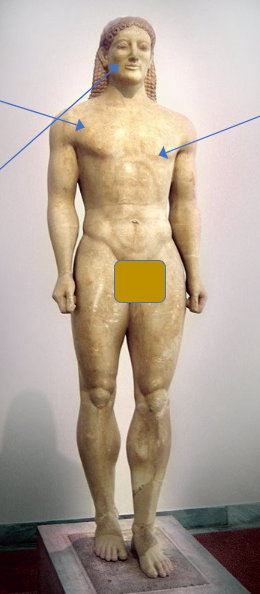
Kore
female youth
clothed and idealised form
archaic smile, arms out to the side or holding out an offering
stiff, block-like characteristics
stylized hair
Kore from Akapolis (510BC)
defined body with defined hips and elaborate clothing
archaic smile

Peplos Kore
young woman wearing peplos → heavy wool garment draping over whole bodly
torse, legs and protrusion of breasts hint at form underneath
paint remenants indicate dress yellow with details in blue and red
animals on dress mean possibly god → artemis
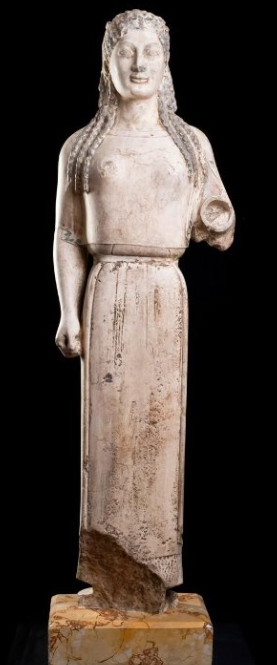
Classical Architecture
The Parthenon
mainly shrines/temples to protect statues of gods
placed central for all to see
show of power
expressed harmony, balance and simplicity
post and lintel
two pillars with a crossbeam
greek temple
designed with progression from outer to inner
open and inclusive space
early greek
stone tied with timber
saw how effect repetition was in Egypy → copied
overtime → become more floral
Fine white marble → Mount Pentelikon
house statue of Athena → didnt survive
wider than other temples
Art in this Period - Classical Art
Discobolos (460 → 450BC)
contrapposto → shifting of weight onto one leg for balance in a sculpture to create a sense of realism
high classical period
looked as if it was filled with potential energy
idealized form frozen in time
Rythmos → refers to measure, proportion or symmetry
One leg bears the weight → contrapposto
one arm tenses, other relaxed → diagonal lines in the composition to guides eyes
new element in classical sculptures → showing potential energy
almost like its the ‘perfect’ moment
composition effects leads to disruption in symmetry which aids sense of balance
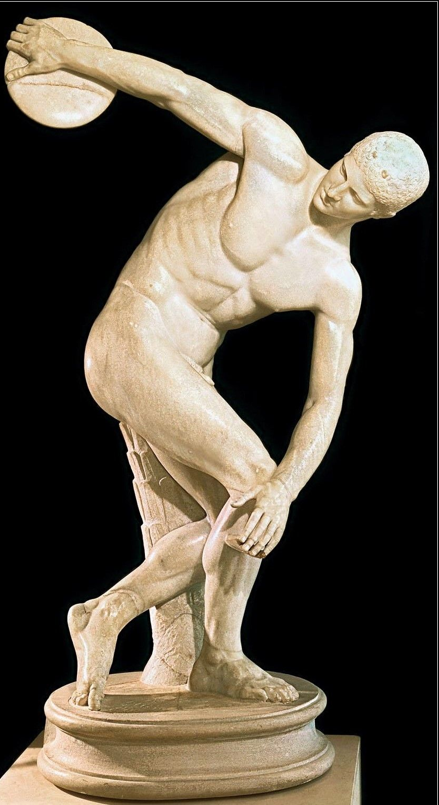
Hellenistic Period
naturilism of body form/ experession for hyper realism
illicts emotioinal response
not idealised, exaggerated → emphasized details
exploration of old age, drunkness, agony
Pathos → the quality or property of anything that touches feelings, stimulates emotions or awaken tender emotions
Lacoon and his Sons (42 → 20BC)
warned Trojans of Trojan horse
lacoon was a trojan priest
athena and posieden sent two serpents to kill him and his two sons
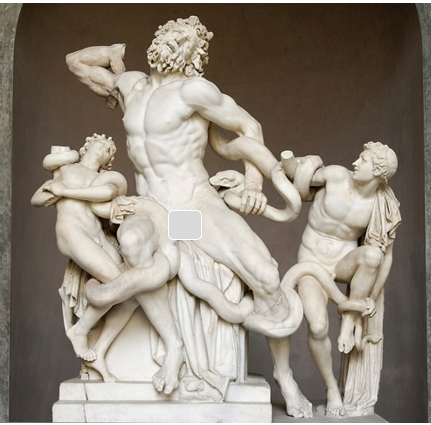
scene filled drama, tension, pathos
figures caught in coil of serpent. faces filled with agony → tensed/strained muscles
diagonal line right to left arm
sons face doom with confusion and despair
sons balance composition
lacoon in contrast to others as closer to death
contrast in texture
carving and detals + musculature of body and deep drilling in hair = hellenstic
Roman History
republican period
two groups
Particans (aristocrats who owned land) → rich (small percentage)
plebians → poor (majority)
civil wars in 276 BC
octavian (Augustus) took power
→
Imperial Age
dictatorship
117 AD empire reached peak (territory expansion)
plagues + incompetent rulers lead to a weakened empire
Diocletian divided the empire to exert more control
Constantine then united the roman empire under his authroity after a series of victories over his rivals
under his rule he legitimsed christianity and moved the cpaital to constantinople
after rule empire divided east and west = decline in political power
Religion
key in maintaining social order within roman empire
roman and greek gods easily compatible so they combined
romans stole other countries beliefs
Augustus exploited the utilitarian aspect of religion
roma dea → said that the emperor was special heritage and link spiritual world (special). promoted Augustus and then Rome
312AD → christianity became dominant and is still to this day
roman art
romans developed their own characteristisc
art used to push agendas
stories of power or success
many early roman artworks copy greek artworks
Augustus of Prima Porta (town found)
shows power of imagery/communicate idealogies
depicted the military victor augustus
statue predicted the 200 year peace ‘Pax Romana’ that he brought on
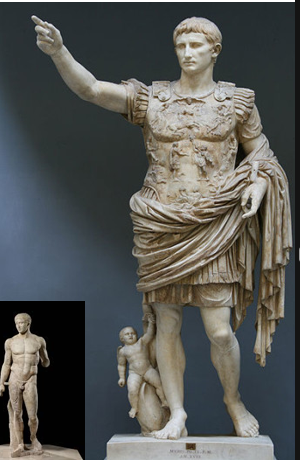
freestanding marble
contrapposto pose → right leg
addressing his troops (arm and clothing)
similiar to a classial greak sculpture of fifth century
like tailors dummy → idealised male form
clothing and head added
shows himself as the ideal greek yet he was a middle aged man
Symbolism
cupid riding dolphin by leg
showing naval victory that made him sole ruler
Cupid thought to be son of Venus
wearing a Cuirass (breast plate) that covered figures with propoganda messages
intends to show he has god on his side
middle two figures represent roman and parthian
left is enemy partian (dipolomatic gcitory over in 20 BC)
right side is female personification of countries he conquered
refers to pax romana → message is that sun will shine on rome bringing peace
two major deities below apollo and diana → his support for traditional roman religion
bottom is tellus (earth goddess)
two bodies and cornucopia → symbol of feritility → overfilled horn = pax romana
expresses his connection to past, military victor and link to gods as roman bringer of peace
Roman Architecture
firstly religion then solving problems (practical)
aquaducts, sewerage, roads, bridges, public baths, basilicas (public building with multiple functions)
aquaducts brought water to city and removed sewearge from city
developments
arches, vaults and domes
post and lintel rexttricted weight and size of building (two pillars with beam across)
vaults + arches into cross vault then dome developed
weight pushed into supportive walls → no longer relied on columns for support
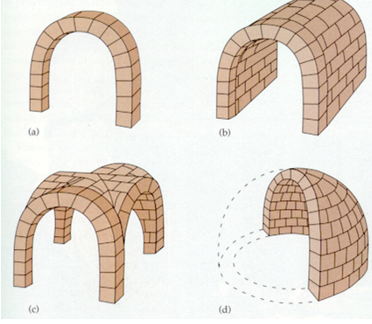
barrlet vault (B) series of arches
cross vault (C) is formed by an intersection
development of slow drying mortar meant they could expand the potential of arch and vault to cover large spaces without interior support
the colosseum and concrete
colosseum made of arches
doric-ionic-corinthian (purely aesthetic)
visually heaviest to lightest
Panthenon
front contains rectangular colonade porch with a tall middle block
16 columns (red and black egyptian granite) → bases and captials of white greek marble
slow drying concrete allowed the granite columns
contrast between rectangularity of portico and circulairty of the rotunda
ceiling guides viewers eye to center by using panels (coffers) that get progressively smaller to the top
circular opening allowed only beam of light in, moved with the time of day singifying the passing of time or intangible light associated with the gods
later converted into church
stood test of time.
Alexis Preller
6th september 1911 pretoria
worked as clerk then left to england 1934
attended west minister school of art until 1935 when he came back
left again in 1937 for paris
visited many african countries
early on he was fascinated by post-impressionist (big V dog) and paul ganguin
use of bright colours and imagitive transformation of nature attracted preller
also inspired Maggie Laubser and Irma Stern
Gold Primavera
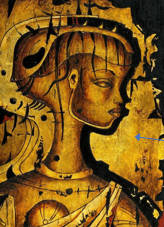
goddess/spirit of spring
repeated the portrait with different colour and scale
relate to african head → basic shape can be seen in other works
emblem of eternal beauty, feminity or masculinity
warm earthyl colours (brown and ochers) yellow and shade light na dark, gives painting jewel-like quality
feeling of antiquity/treasure further enhanced by gold leaves peeling around edges
shapes and figures used to making aging
coming of new season
stylised → linked to his interpretation of an african woman
through repeating the artwork, he gave it some sort of importantance and sacredness → similiar jesus
personal syle can be connected to westerninfluences such as surrealism
inspiration from his travels through africa → tribal life, dress and rituals
his works make you feel as if you are in an undiscovered kingdom with mythical figures and creatures. Created his own universe with exoticness. Own unique artistic imagery → visual form to his world.
Judith Mason
born in pretoria 1938
extensive career as a teacher
started at witwaterstrand, them uni of Pretoria, then Michaelis then a school in Florence, Italy
oil paintins, pencil works, printmaking and mixed media
current religion and ancient mythology
motivated by a strong social conscience
Informed by people, creatures, events and sometimes poetry that invoked strong emotion (pathos)
She brings her undestadnig of things to bring order to choas of the world. She is agnostic person filled with religous curiosity. Convey energy and presence on a canvas.
origin of western symbolism → most basic characteristics of human beings
explored the reason that humans act and think way they do
Arachne
oil on board
female figure alone in dark with her head bent forward
ears as holes
pink-fleshy colour → opaque
dark eyes swollen → highlight strain of weaving
hump on back from continous bending
cannot tell gender apart from breasts
web of nooses acting as clothing → still expose breasts
masculine hands hold a single knot
her clothing nooses hang outside painting → bound by something outside the space
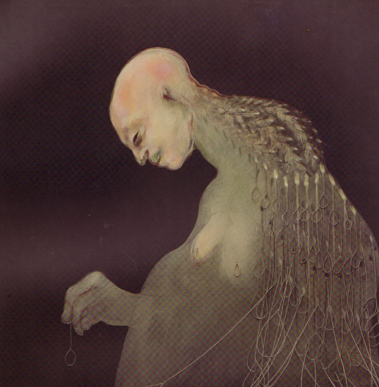
pitch black background → loneliness
focussed on noose = attempted suicide → background shows how she is trapped in her state of mind
shows how human beings have authority over one another and not necessarily gods
contrast of beauty and ugliness (common in her artworks) + figurative style and colour use
question human behaviour/mythologies could shed light on why humans act the way they do